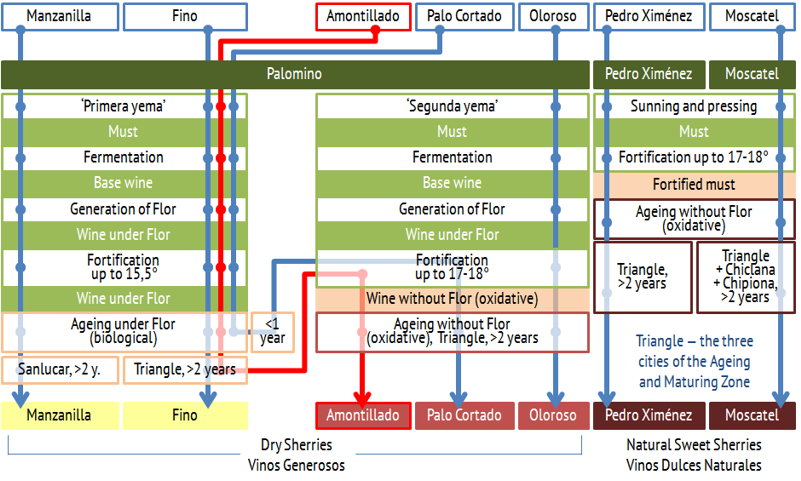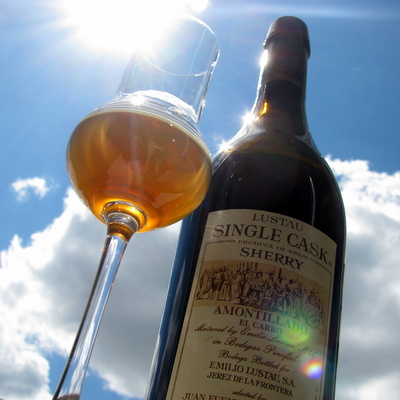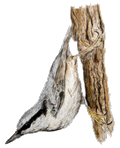
- Sherry Wine:
- Production
- Classification
- Cities & Bodegas
- Tastings
- Analogues
- Authors & Contacts
- Ðóññêèé ñàéò
Sherry wine types
Amontillado
Olga Nikandrova and Denis Shumakov.
Amontillado is a dry sherry which has undergone long biological ageing and then full-length oxidative ageing. Perhaps, technologically this is the most sophisticated sherry. However it is very easy to speak about it, since its processing chain combines processing chains of Fino or Manzanilla (at the stage of biological ageing) and Oloroso (at the stage of oxidative ageing).

It is important to note the following.
First, Amontillado is actually produced from biologically-aged sherries (Fino or Manzanilla) and inherits their technological characteristics (minimum 2-3 years under flor in the Criaderas and Solera system) as well as their raw material (first extraction must of Palomino grape).
Second, the wine which is to become Amontillado is fortified twice. At first — prior to and for the purpose of biological ageing (up to 15-15,5°), then — after ageing under flor, to start oxidative ageing (up to 17-18°).
Third, as is the case with Oloroso, at the stage of oxidative ageing dynamical system is not critical for producing Amontillado — without flor the wine can be aged according to Añada system. Nevertheless most Amontillados are matured in the Criaderas and Solera system (minimum two years).
Forth, during oxidative ageing, Amontillado, just like Oloroso, gains alcoholic strength and becomes more saturated.
Amontillado is dry wine with sugar content less than 5 gram per liter, alcohol value — 16-22°, and color ranging from topaz to amber. The wine’s aroma is subtle and delicate, with harmonious notes of roasted almonds, hazelnuts, herbs and tobacco. The taste is smooth, comfortable, full and harmonious, often with notes of iodine. Complex aftertaste. Taking Amontillado’s taste and aroma down into components, one would find there notes of Manzanilla and Fino as well as the ones of Oloroso. Although, of course, such analysis will rather be of intellectual than sensual nature — in fact Amontillado’s taste and aroma are solid and have their own peculiarity.
Amontillado’s neighbors in the sherry line are Oloroso and Palo Cortado. Amontillado differs a lot from Oloroso — by the fact that it had a period of biological ageing and by the raw material (first extraction for Amontillado and second — for Oloroso). The differences between Amontillado and Palo Cortado are a bit more tricky. Their main formalizable difference is the length of biological ageing. For Amontillado it is minimum two years, for Palo Cortado — one year on average (often much shorter than that). This seemingly insignificant difference may have a rather strong impact on the taste.
Amontillado, as well as other oxidatively-aged sherries, can be the basis for other sherry specialties — mostly they are old sherries certified as VOS or VORS — that is sherries with average age of 20 and 30 years respectively. They can also be other age-dated sherries and hard-to-systemize specialties — such single barrel sherries, for example.
The etymology of the word “Amontillado” is the most intriguing of the sherry names. It derives from words “ad Montilla” which means “done in the manner of Montilla”. Where Montilla (or rather Montilla-Moriles) is a wine region to the right on the map from the Jerez Region. Wines similar to sherries are produced there, and the name “Amontillado” may be interpreted as “wine similar to the from Montilla”.
The stylistics of serving Amontillado and tasting it (looking ahead a bit, it refers to Palo Cortado as well) is identical to the stylistics of serving and tasting Oloroso. A comprehensive and no-lose glass for Amontillado may be a special sherry Catavino or its ITG-alternative. If you are going to drink Amontillado on its own, with some tapas or with very light snacks, you may downscale the glass-ware up to a small distillate glass, for example. If Amontillado is to be paired with main dishes, the glass may be enlarged — up to a white wine glass.

Sometimes Amontillado may be single-barrel
Traditional serving temperature for Amontillado is 12-14°C. But you can just as well vary its cooling degree. Old Amontillados may change their taste and aroma quite noticeably within a week after the bottle was uncorked. Everything may be fine right after opening, then in short time there appears an evident and alarming acidity, and then it disappears and here comes happiness. Such a week-long harmonizing should, probably, be considered decantation. Uncorked and closed again bottle of Amontillado can stored in the fridge for a month without any notable loss of quality.
The Regulatory Council recommends to pair Amontillado with almonds, olives, jamon (and other Iberian-style meat delicacies), asparagus, mushrooms, vegetable cream-soups, slightly smoked and salty fish, rabbit and lamb. It’s evident that the list may be prolonged with a couple dozen more dishes gastronomically close to the mentioned ones. Classic mushroom soup with chanterelle and boletus may be a very good example.
And the last thing to mention. A text about Amontillado requires mentioning of Edgar Allan Poe’s “The Cask of Amontillado”. Everyone does it and we must honor traditions. Everyone does it and we must honor this tradition. This short story is not about wine, of course. Moreover, one phrase in this story — “Luchresi cannot tell Amontillado from Sherry” — suggests that the wine there is not from the Jerez Region but rather from the parts which now constitute Montilla-Moriles. But it doesn’t change anything.
Because in his story Edgar Allan Poe very accurately reflected one Amontillado’s feature. Amontillado (even a bottle, not mentioning a cask) is a sure way to attract the attention of a connoisseur, it has some fascinating magnetism. Even Palo with its rarity and collectible value does not have this fatal charm.
It must be in the name.
Amontillados reviewed on the website (in Russian only):
— Lustau Amontillado Bodega Vieja
— Lustau Almacenista Amontillado del Puerto (Gonzalez Obregón)
— González Byass Viña AB Amontillado
— González Byass Del Duque
— Williams & Humbert Jalifa Amontillado 30 Años
— Amontillado Viejo Pastrana
— Taberna la Manzanilla Amontillado Viejo
— Lustau Single Cask Amontillado El Carro
— Amontillado Romate
— Pedro’s Almacenista Selection Amontillado
— Lustau Dry Amontillado Los Arcos
— Amontillado Alexandro
— Quady Winery Palomino Fino
— Equipo Navazos La Bota de Amontillado «Bota NO» (nº 31)
— Gran Barquero Amontillado
— Mazuran’s Amontillado Dry Sherry
— Amontillado Tradición V.O.R.S.
— Amontillado NPU
— Amontillado Viejísimo Tradición
— Lustau Rare Amontillado Escuadrilla
Read next — Palo Cortado.
Warning!
This site can contain information about drinks excessive consumption of which may cause harm to health and is unadvisable for people who didn’t come of age.
Share Sherry
- Sherry.wine, FEDEJEREZ
- Copa Jerez, Sherry Week
- Sherry Notes, Jerez de Cine
- Los Generosos, Criadera
- Jerez-Xeres-Sherry
- Los Vinos de Jerez
Articles
- There are more articles in Russian than in English in this website. Sorry :(
Reviews
- To our great regret, we didn’t have time to translate tasting and traveling notes into English. But, if you want, you can see them in Russian.

